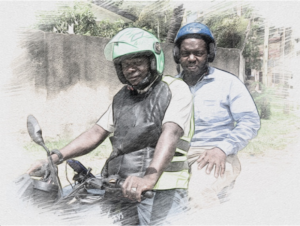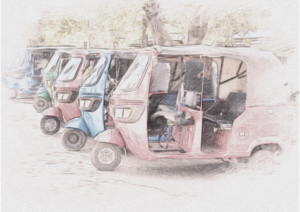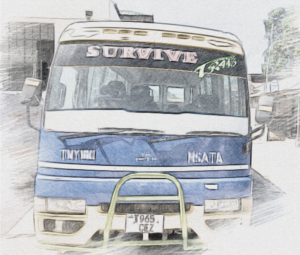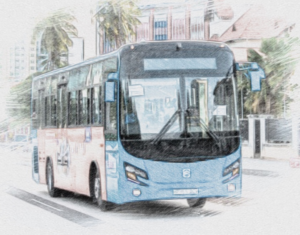So you’ve landed at Julius Nyerere International Airport in Dar es Salaam and now you need to get to your hotel. Do you reach for your Uber or Bolt app or are you going to throw yourself into Tanzanian life and try local transport? Here’s a guide to help you decide how, why and when to use public transport in Tanzania.

Let’s start with arguable the most iconic East African transport, the ubiquitous boda boda motorbike taxi.
This cheap and convenient form of transport originally emerged to fill the gap in often irregular and unreliable public transport.
So popular has it become that both Uber and Bolt have a boda boda option on their app. These operators use only trained riders and always carry a helmet for the passenger.
One of the main benefits of a motorbike is its ability to manoeuvre through traffic, weaving its way between lines of cars at traffic lights, occasionally taking to the pavement and sometimes nipping the wrong way down a none-way street.
They are therefore popular with commuters wanting the beat rush hour jams choked with static dala dala and taxis.
A rise in the availability of credit and cheap imports from India and China have fuelled the increased in the number of boda boda in the region. There are not only many more new drivers but numerous motorbike repair centres have sprung up to support this growing industry.


The bajaj is the three-wheeled motorbike known as a tuk tuk in the Far East and India. They are a step up in comfort from a boda boda with the added benefit of providing shelter from the sun and rain.
The sheet metal body, canvas sides and roof offer a level of privacy not possible on a motorbike.
The bajaj is a common sight in Dar es Salaam providing the same sense of fun as a motorbike ride but with greater safety. A ride in a bajaj will cost about the same price as hanging onto the back of a boda boda but will bounce you around a bit more. Be careful to tuck your bags away from the open door and hang on tight at sharp corners.
Rides start from about 2,000 and can go up to 10,000 for a journey across the city. Most journeys will be in the range of 3,000 – 5,000TSH


The dala dala is common across the city and loved by many as a cheap solution to getting from A to B. They are adorned with messages of encouragement and religious quotes giving a clue to the character and faith of the driver.
It’s the most popular form of transport for lower income residents as it offers a very economical and convenient way to get around.
But there’s a catch of course. Buses are usually overcrowded and hot, especially in the window seats, there is an increased risk of pick-pockets and unless you get on at the beginning of the route, you will end up having to stand for the entire journey.
For travellers who want to get under the skin of Tanzania, a trip in a dala dala is a must. If you’re feeling brave or are on a seriously tight budget, take a dala dala between towns and cities. They are a lot cheaper than the long-distance coaches but be warned. They don’t have toilet stops so you should be prepared to sit in the same seat for eight or nine hours without moving.
A typical journey within the city costs 400 TSH and inter-city dala dala charge around 12,000 TSH for a 9 hour journey. You don’t have to wait long for a dala dala to arrive anywhere in Tanzania but you might not be able to climb aboard once the door opens.


DART – Dar Rapid Transit
This new bus service was launched in 2016 and today connects the suburbs to the central business district using dedicated traffic lanes for much of the way.
Buses operate from 5am to 11pm each day and fares are a very cheap 400 – 800 TSH. This makes DART one of the cheapest ways to move in and out of the city centre. However for those who don’t live near a station it’s not very convenient at all.
The Chinese built vehicles are new and spacious but at busy times, can be just as crowded as dala dala. The dedicated lanes mean that sitting (or more likely standing) on the bus, you’ll find yourself cruising past slow-moving cars and taxis. Stations along the routes are huge cavernous spaces giving shelter from the elements which is useful.


For an alternative to flights, the inter-city coach is more comfortable than the dala dala and generally (but not always) only accepts passengers who have a seat.
On longer journeys passengers are able to stretch their legs and take a toilet break every two or three hours. If you don’t want to leave the coach to get lunch, there are hawkers at every stop. They sell not only food and drinks but useful items like power packs, ear phones, watches and sunglasses.
Coaches are fitted with a TV screen at the front and often play soap operas for the entire journey. The sound is played loud enough for everyone in the bus to enjoy the drama, even you! Although the coach is more expensive, it still offers great value for money and a reasonable level of comfort. Depending on your route, you might also get a glimpse of wild animals such as giraffe, zebra, baboon, kudu and gazelle as you pass through game reserves.
A journey of 10 hours will typical cost you around 30,000 TSH. These coaches also cross international borders including Kenya, Rwanda and Uganda so are popular with foreign backpackers on a budget.

In summary, when you are thinking about which public transport to use, there is a trade-off between price, convenience and safety, and the transport you eventually choose will depend just as much on what’s available at the time as on your preference.
For long distance road journeys you’ll need to choose between a coach and a dala dala but in Dar itself, you can hop on a boda boda, jump into a bajaj or squeeze yourself onto a dala dala. However, it’s worth noting that if you want to get right into the heart of the central business district, the city authorities have prohibited boda boda and bajaj from operating there. If you take one of these, don’t be surprised if they drop you off short of your destination and you have to walk or get a taxi the final mile. The answer is to get a licensed taxi, Uber or Bolt.